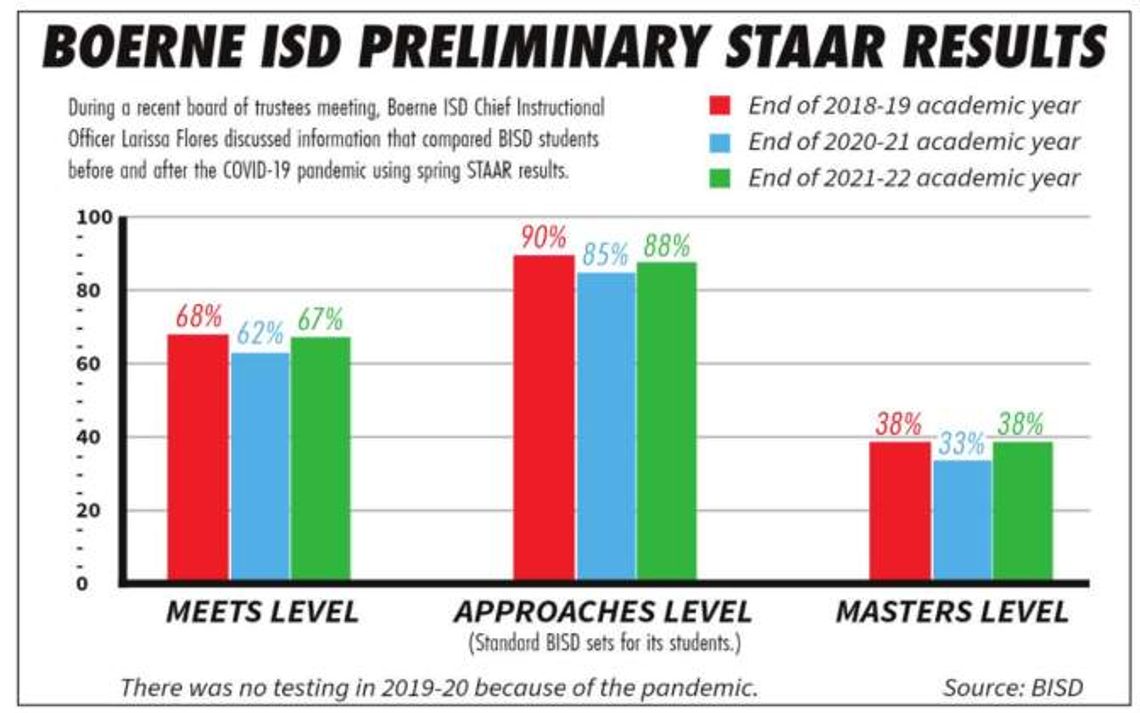Boerne Independent School students continued to make progress and in many areas now have made up the ground lost during the COVID-19 pandemic, according to preliminary 2022 STARR results.
Chief Instructional Officer Larissa Flores updated trustees on that progress during the board’s June meeting.
Flores reminded the trustees that student success is one of the four elements making up BISD’s 2021-22 scorecard. Specifically, that success is geared toward preparing students to be college, career and military ready.
STAAR is the state’s testing program and is based on state curriculum standards in core subjects, including reading, writing, math, science and social studies, information from the Texas Education Agency’s website states. Grades 3-8 STAAR tests are given in the spring. End-ofcourse assessments are given throughout the year.
“STAAR tests are designed to measure what students are learning in each grade and whether or not they are ready for the next grade,” TEA’s information reads. “The goal is to ensure that all students receive what they need to be academically successful.”
TEA also states that meeting the individual student needs depends greatly on schools, parents and community members working together.
Flores discussed information that compared BISD students before and after the COVID-19 pandemic. It showed that at the end of the academic year in 2019, 68 percent of the district’s students – in all grades and subject areas tested – were at the “meets” testing level. “Meets” is the standard BISD sets for all of its students.
A year ago, 62 percent of students were meeting the criteria. This year, the number increased to 67 percent.
The information also showed the percentage of all students who are both “approaching” and “mastering” the academic material. In 2019, 90 percent were at the “approaches” level compared to 85 percent in 2021 and 88 percent in 2022. In the “masters” category, 38 percent of students were there in 2019, 33 percent last year and 38 percent this year.
There was no testing in 2020 because of the pandemic.
It also was noted that with the growing enrollment in the district, there were more students being tested this year than three years ago.
2021-22 year
Flores also showed the progress district students made during the recently completed academic year, comparing the beginning of the year goal to the end of the year STAAR results.
In most cases, the goals were met or exceeded. The percentages were based on the number of students who met the established criteria.
In third grade, the math goal was 51 percent and the EOY number was 61 percent. In reading, the goal was 59 percent and the EOY result was 71 percent.
In fourth grade, the math goal was 51 percent and the year-end “meets” percentage was 57. In reading, the two numbers were 55 percent (goal) and 69 percent (EOY).
Fifth-graders were tested in math, reading and science. The math goal was 51 percent and students far surpassed it with 67 percent at the “meets” level by the end of the year. In reading, the goal was 59 percent and 75 percent of students were at the “meets” level at EOY testing.
Science was a different story, however, as the district goal was 60 percent of students being at the “meets” level at EOY testing. That percentage ended up being at 58.
In middle school, sixth- and seventh-graders were tested in math and reading, and in all cases the goals were met.
In sixth grade, the math goal was 62 percent, and that was the EOY number. In reading, the goal was 50 percent and the EOY percentage was 58.
In seventh grade, the math goal was 61 percent and 64 percent of students ended the year at the “meets” level. In reading, the goal was 50 percent, and the year-end number was 74 percent.
Eighth-graders were tested in four core areas, and two of those fell short of the mark.
In math, the target was 61 percent, but only 57 percent of students were at the “meets” level at the end of the year. In social studies, the goal was 57 percent, but only 47 percent of students got there by the end of the year.
In reading, the goal was 68 percent, and 74 percent of students reached it. In science, the target was 71 percent and the final number was 74 percent.
Eighth-graders also were tested in algebra 1, and a 97 percent end-of-course goal was set. At the end of the year, 97 percent of students had reached the goal.
High school students were tested in algebra, English, U.S. history and science.
The algebra goal was 42 percent and 46 percent of students were at the “meets” level at the end of the year.
Students were tested in both English 1 and 2. In English 1, the “meets” goal was 79 percent, but only 74 percent of students got there by the end of the year. In English 2, the target was 82 percent, and the year ended on that number.
In history and biology, BISD students fell short of the goals. In history, the target was 88 percent, but only 86 percent of students were at the “meets” level at the end of the year. In biology, the goal was 81 percent and the final number was 77 percent.
Flores said the subject areas in which students fell short of the goals will be “the main area of focus” heading into the new school year.
“STAAR tests are designed to measure what students are learning in each grade and whether or not they are ready for the next grade. The goal is to ensure that all students receive what they need to be academically successful.”
–Texas Education Agency







Comment
Comments